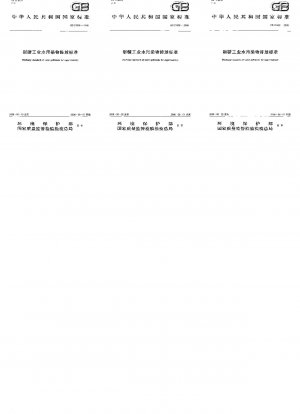GB 21909-2008
Discharge standard of water pollutants for sugar industry (English Version)
- Standard No.
- GB 21909-2008
- Language
- Chinese, Available in English version
- Release Date
- 2008
- Published By
- General Administration of Quality Supervision, Inspection and Quarantine of the People‘s Republic of China
- Latest
- GB 21909-2008
- Scope
- This standard specifies the discharge limits of water pollutants from sugar factories or production facilities. This standard applies to the management of water pollutant discharge of existing sugar factories or production facilities. This standard applies to the environmental impact assessment of sugar industry construction projects, the design of environmental protection facilities, the completion of environmental protection acceptance and the management of water pollutant discharge after they are put into operation. This standard applies to the discharge of pollutants permitted by law. The site selection of newly established pollution sources and the management of existing pollution sources in special protection areas shall be in accordance with the "Law of the People's Republic of China on Prevention and Control of Air Pollution", "Law of the People's Republic of China on Prevention and Control of Water Pollution", "Law of the People's Republic of China on Marine Environmental Protection" and "The People's Republic of China The Law of the People's Republic of China on the Prevention and Control of Environmental Pollution by Solid Waste, the Law of the People's Republic of China on the Prevention and Control of Radioactive Pollution, the Law of the People's Republic of China on Environmental Impact Assessment, and other laws, regulations, and rules are implemented. The water pollutant discharge control requirements stipulated in this standard are applicable to the discharge behavior of enterprises to environmental water bodies. When an enterprise discharges wastewater into the urban drainage system with a sewage treatment plant, the pollutant discharge control requirements shall be negotiated between the enterprise and the urban sewage treatment plant or implement relevant standards based on its sewage treatment capacity, and reported to the local environmental protection authority for record; urban sewage The treatment plant should ensure that the discharged pollutants meet the requirements of the relevant discharge standards. When a construction project intends to discharge wastewater into the urban drainage system with a sewage treatment plant, the construction unit and the urban sewage treatment plant shall implement the provisions of the preceding paragraph.
GB 21909-2008 Referenced Document
- GB/T 11893-1989 Water quality--Determination of total phosphorus--Ammonium molybdate spectrophotometric method
- GB/T 11894-1989 Water quality--Determination of total nitrogen--Alkaline potassium persulfate digestion-UV spectro photometric method
- GB/T 11901-1989 Water quality--Determination of suspended substance--Gravimetric method
- GB/T 11914-1989 Water quality--Determination of the chemical oxygen demand--Dichromate method
- GB/T 6920-1986 Water quality--Determination of pH value--Glass electrode method
- GB/T 7478-1987 Water quality--Determination of ammonium--Distillation and titration method
- GB/T 7479-1987 Water quality--Determination of ammonium-Nessler's reagent colorimetric method
- GB/T 7481-1987 Water quality--Determination of ammonium--Spectrophotometric method with salicylic acid
- GB/T 7488-1987 Water quality--Determination of biochemical oxygen demand after 5 days(BOD5)--Dilution and seeding method
- HJ/T 195-2005 Water quality - Determination of ammonia-nitrogen Gas-phase molecular absorption spectrometry
- HJ/T 199-2005 Water quality Determination of tota-nitrogen Gas-phase molecular absorption spectrometry
- HJ/T 399-2007 Water quality- Determination of the chemical oxygen demand - Fast digestion-spectrophotometric method
GB 21909-2008 history
- 2008 GB 21909-2008 Discharge standard of water pollutants for sugar industry
